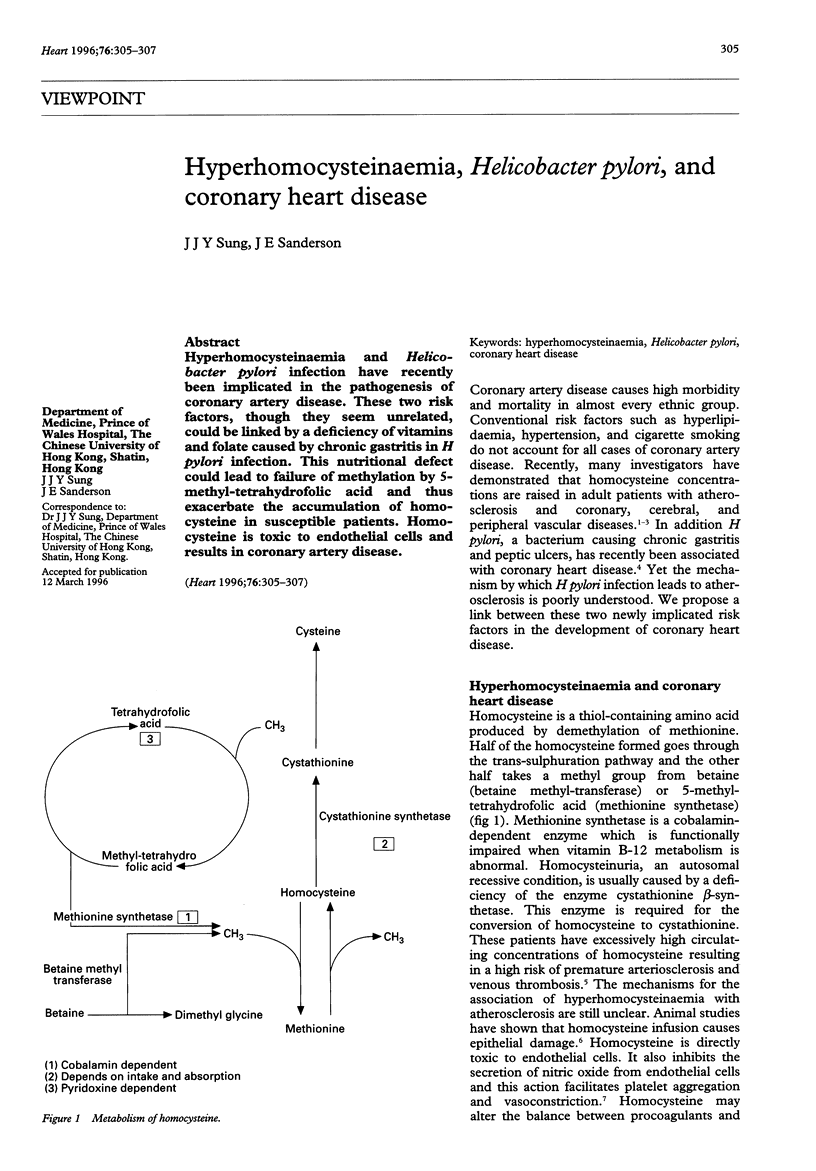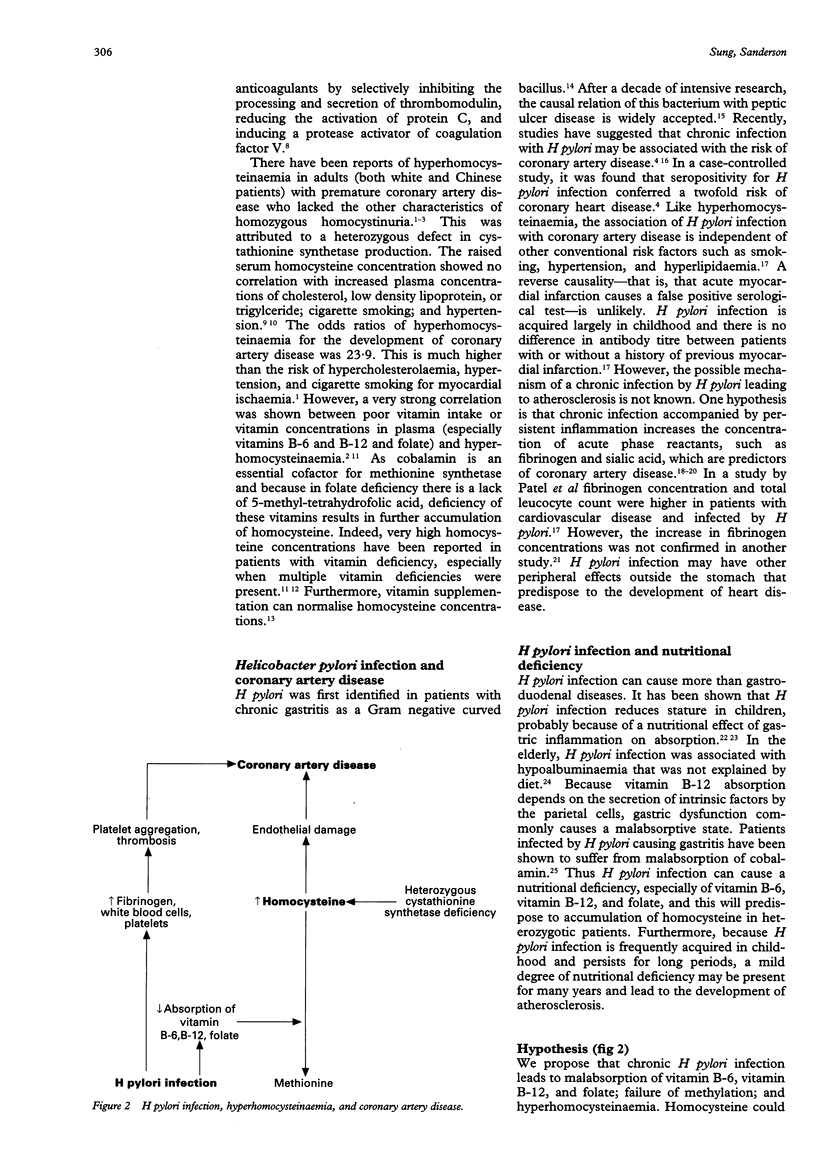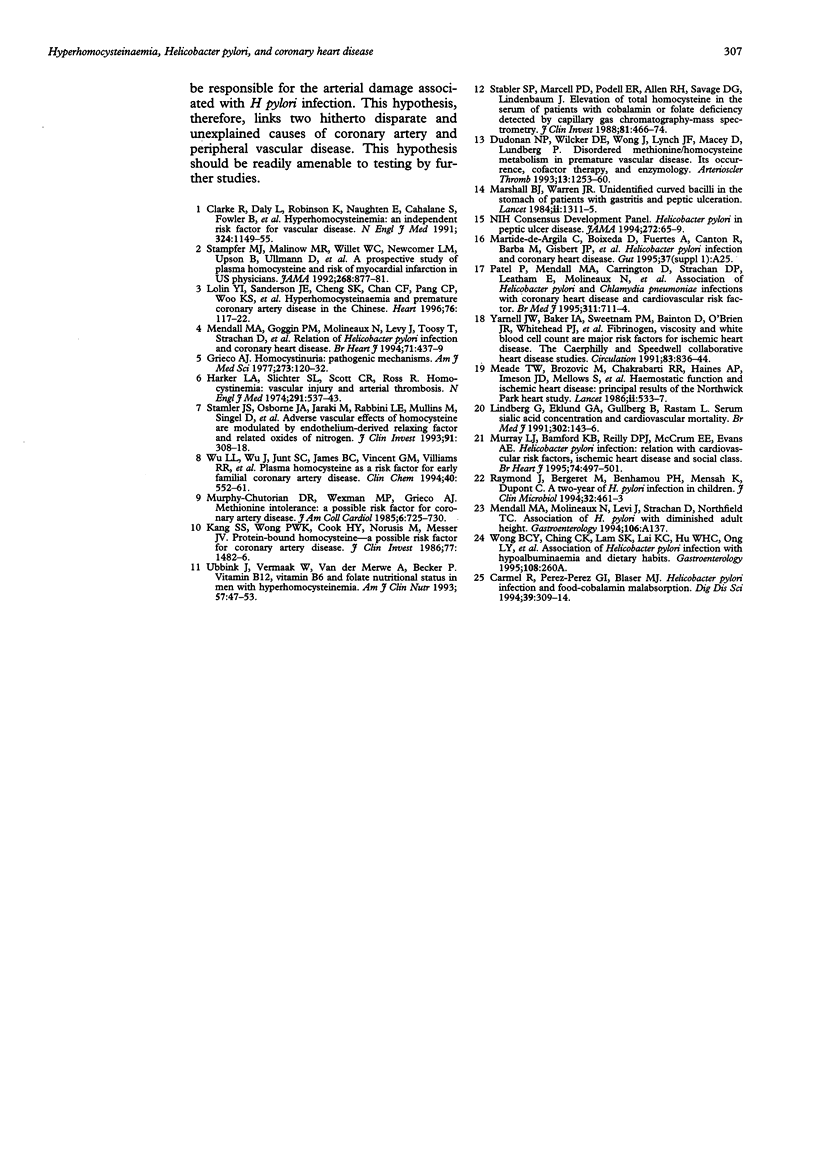Abstract
Hyperhomocysteinaemia and Helicobacter pylori infection have recently been implicated in the pathogenesis of coronary artery disease. These two risk factors, though they seem unrelated, could be linked by a deficiency of vitamins and folate caused by chronic gastritis in H pylori infection. This nutritional defect could lead to failure of methylation by 5-methyl-tetrahydrofolic acid and thus exacerbate the accumulation of homocysteine in susceptible patients. Homocysteine is toxic to endothelial cells and results in coronary artery disease.
Full text
PDF


Selected References
These references are in PubMed. This may not be the complete list of references from this article.
- Carmel R., Perez-Perez G. I., Blaser M. J. Helicobacter pylori infection and food-cobalamin malabsorption. Dig Dis Sci. 1994 Feb;39(2):309–314. doi: 10.1007/BF02090202. [DOI] [PubMed] [Google Scholar]
- Clarke R., Daly L., Robinson K., Naughten E., Cahalane S., Fowler B., Graham I. Hyperhomocysteinemia: an independent risk factor for vascular disease. N Engl J Med. 1991 Apr 25;324(17):1149–1155. doi: 10.1056/NEJM199104253241701. [DOI] [PubMed] [Google Scholar]
- Dudman N. P., Wilcken D. E., Wang J., Lynch J. F., Macey D., Lundberg P. Disordered methionine/homocysteine metabolism in premature vascular disease. Its occurrence, cofactor therapy, and enzymology. Arterioscler Thromb. 1993 Sep;13(9):1253–1260. doi: 10.1161/01.atv.13.9.1253. [DOI] [PubMed] [Google Scholar]
- Grieco A. J. Homocystinuria: pathogenetic mechanisms. Am J Med Sci. 1977 Mar-Apr;273(2):120–132. [PubMed] [Google Scholar]
- Harker L. A., Slichter S. J., Scott C. R., Ross R. Homocystinemia. Vascular injury and arterial thrombosis. N Engl J Med. 1974 Sep 12;291(11):537–543. doi: 10.1056/NEJM197409122911101. [DOI] [PubMed] [Google Scholar]
- Kang S. S., Wong P. W., Cook H. Y., Norusis M., Messer J. V. Protein-bound homocyst(e)ine. A possible risk factor for coronary artery disease. J Clin Invest. 1986 May;77(5):1482–1486. doi: 10.1172/JCI112461. [DOI] [PMC free article] [PubMed] [Google Scholar]
- Lolin Y. I., Sanderson J. E., Cheng S. K., Chan C. F., Pang C. P., Woo K. S., Masarei J. R. Hyperhomocysteinaemia and premature coronary artery disease in the Chinese. Heart. 1996 Aug;76(2):117–122. doi: 10.1136/hrt.76.2.117. [DOI] [PMC free article] [PubMed] [Google Scholar]
- Marshall B. J., Warren J. R. Unidentified curved bacilli in the stomach of patients with gastritis and peptic ulceration. Lancet. 1984 Jun 16;1(8390):1311–1315. doi: 10.1016/s0140-6736(84)91816-6. [DOI] [PubMed] [Google Scholar]
- Meade T. W., Mellows S., Brozovic M., Miller G. J., Chakrabarti R. R., North W. R., Haines A. P., Stirling Y., Imeson J. D., Thompson S. G. Haemostatic function and ischaemic heart disease: principal results of the Northwick Park Heart Study. Lancet. 1986 Sep 6;2(8506):533–537. doi: 10.1016/s0140-6736(86)90111-x. [DOI] [PubMed] [Google Scholar]
- Mendall M. A., Goggin P. M., Molineaux N., Levy J., Toosy T., Strachan D., Camm A. J., Northfield T. C. Relation of Helicobacter pylori infection and coronary heart disease. Br Heart J. 1994 May;71(5):437–439. doi: 10.1136/hrt.71.5.437. [DOI] [PMC free article] [PubMed] [Google Scholar]
- Murphy-Chutorian D. R., Wexman M. P., Grieco A. J., Heininger J. A., Glassman E., Gaull G. E., Ng S. K., Feit F., Wexman K., Fox A. C. Methionine intolerance: a possible risk factor for coronary artery disease. J Am Coll Cardiol. 1985 Oct;6(4):725–730. doi: 10.1016/s0735-1097(85)80473-3. [DOI] [PubMed] [Google Scholar]
- Patel P., Mendall M. A., Carrington D., Strachan D. P., Leatham E., Molineaux N., Levy J., Blakeston C., Seymour C. A., Camm A. J. Association of Helicobacter pylori and Chlamydia pneumoniae infections with coronary heart disease and cardiovascular risk factors. BMJ. 1995 Sep 16;311(7007):711–714. doi: 10.1136/bmj.311.7007.711. [DOI] [PMC free article] [PubMed] [Google Scholar]
- Raines D. E., Hogue C. W., Jr, Wickens C., Welch J., Risk S. C. Artifactual hypertension due to transducer cable malfunction. Anesthesiology. 1991 Jun;74(6):1149–1151. doi: 10.1097/00000542-199106000-00027. [DOI] [PubMed] [Google Scholar]
- Raymond J., Bergeret M., Benhamou P. H., Mensah K., Dupont C. A 2-year study of Helicobacter pylori in children. J Clin Microbiol. 1994 Feb;32(2):461–463. doi: 10.1128/jcm.32.2.461-463.1994. [DOI] [PMC free article] [PubMed] [Google Scholar]
- Stabler S. P., Marcell P. D., Podell E. R., Allen R. H., Savage D. G., Lindenbaum J. Elevation of total homocysteine in the serum of patients with cobalamin or folate deficiency detected by capillary gas chromatography-mass spectrometry. J Clin Invest. 1988 Feb;81(2):466–474. doi: 10.1172/JCI113343. [DOI] [PMC free article] [PubMed] [Google Scholar]
- Stamler J. S., Osborne J. A., Jaraki O., Rabbani L. E., Mullins M., Singel D., Loscalzo J. Adverse vascular effects of homocysteine are modulated by endothelium-derived relaxing factor and related oxides of nitrogen. J Clin Invest. 1993 Jan;91(1):308–318. doi: 10.1172/JCI116187. [DOI] [PMC free article] [PubMed] [Google Scholar]
- Stampfer M. J., Malinow M. R., Willett W. C., Newcomer L. M., Upson B., Ullmann D., Tishler P. V., Hennekens C. H. A prospective study of plasma homocyst(e)ine and risk of myocardial infarction in US physicians. JAMA. 1992 Aug 19;268(7):877–881. [PubMed] [Google Scholar]
- Ubbink J. B., Vermaak W. J., van der Merwe A., Becker P. J. Vitamin B-12, vitamin B-6, and folate nutritional status in men with hyperhomocysteinemia. Am J Clin Nutr. 1993 Jan;57(1):47–53. doi: 10.1093/ajcn/57.1.47. [DOI] [PubMed] [Google Scholar]
- Wu L. L., Wu J., Hunt S. C., James B. C., Vincent G. M., Williams R. R., Hopkins P. N. Plasma homocyst(e)ine as a risk factor for early familial coronary artery disease. Clin Chem. 1994 Apr;40(4):552–561. [PubMed] [Google Scholar]
- Yarnell J. W., Baker I. A., Sweetnam P. M., Bainton D., O'Brien J. R., Whitehead P. J., Elwood P. C. Fibrinogen, viscosity, and white blood cell count are major risk factors for ischemic heart disease. The Caerphilly and Speedwell collaborative heart disease studies. Circulation. 1991 Mar;83(3):836–844. doi: 10.1161/01.cir.83.3.836. [DOI] [PubMed] [Google Scholar]


